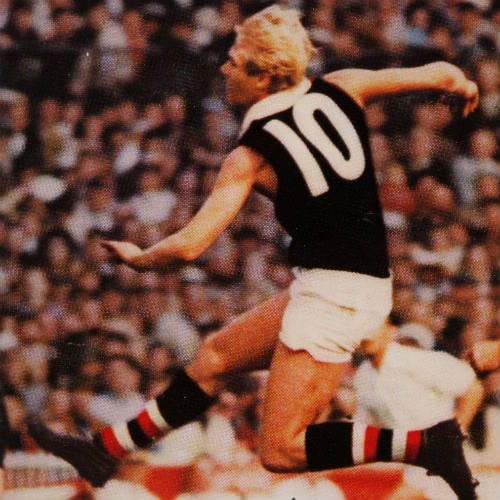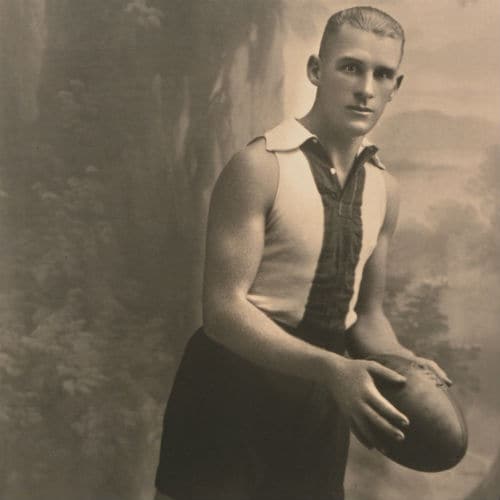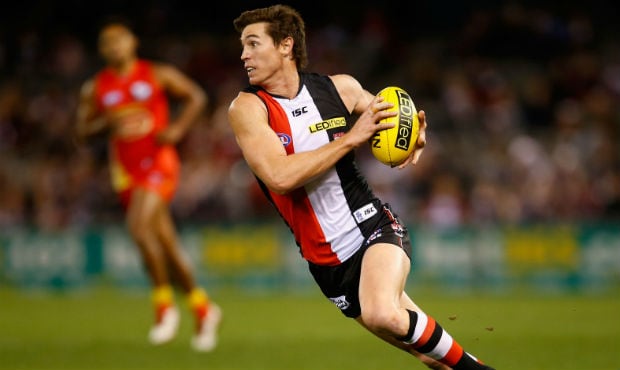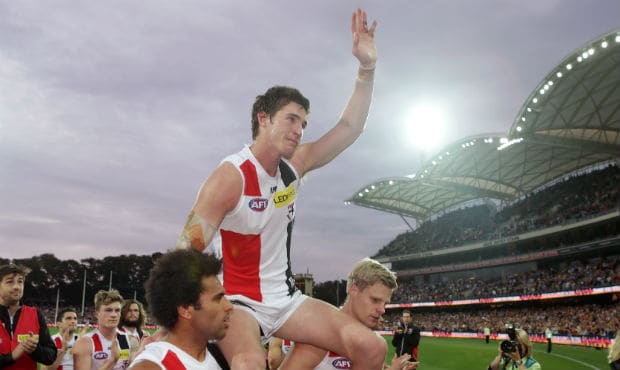TWENTY years go, St Kilda historian Russell Holmesby documented his top 20 Saints of all time. Before the days of social media and comment streams at the foot of online articles, the list wasn't as widely publicised as it would have been in today's world.
Since then, the Saints have played in four Grand Finals and produced some of the greatest players of the modern era, leading Holmesby to extend his list by five.
This is Russell Holmesby's top 25, rankings 10-6.
Click HERE to view the original top 20.
Click HERE to view players ranked 25-21.
Click HERE to view players ranked 20-16.
Click HERE to view players ranked 15-11.
Who will be ranked No.5? Find out Wednesday 7 January.
10. Carl Ditterich (7)
Born: October 10, 1945
Debut: Round 1, 1963
Games: 285 (203 St Kilda, 82 Melbourne)
Goals: 199
Height: 193cm
Weight: 91kg
Ditterich was one of the most feared ruckmen in League history and was a star from his very first game after moving from East Brighton. That was in an opening round match against Melbourne in 1963. Ditterich easily was best on the ground and his ruck play was a revelation.
Ironically he had been disappointed on the Thursday night when he didn't hear his name called in the reserves team and thought he had been left out altogether. On hearing he had been selected his main thought was that he could start building a deposit for a car. Ditterich mixed brilliant marking and strong ruck play with raw aggression and often was in trouble with the League Tribunal.
In fact, suspension cost him a place in the 1966 St Kilda premiership side when he was disqualified for six weeks for striking Fitzroy's Daryl Peoples in the second last round. He hated the media spotlight, but said in later years that he found it difficult to divorce himself from the publicity. When he was criticised for seeking a deferral in his national service he was unjustly criticised despite the fact his parents were both seriously ill.
He resented the press intrusion over the issue. After the hoopla surrounding his debut he said he was brought back to earth when he encountered Carlton star John Nicholls in his second game. His fierce determination may have stemmed from his childhood when he had to overcome the handicap of knock knees and had to wear calipers.
From an early stage of his VFL career he suffered severe ankle problems. In desperate attempts to support his ankles he even had wet plaster applied to them and used venetian blind tape as well as having surgical boots made. Ditterich won the Saints' best and fairest in 1968, but joined Melbourne under the short-lived 10-year rule in 1973 and won the Demons' best and fairest that year.
He returned to St Kilda as captain for the 1976-77 seasons and had a fine 1978 season apart from a mid-season drama when he walked out of the club in frustration over a succession of reports. He was invited to accept the position of captain-coach of Melbourne for 1979-80 and was a potent force right up to his retirement. His replacement as coach - Ron Barassi - said in later years that he should have urged Ditterich to remain at the club as a player for another year.

Carl Ditterich was a giant of the 1960s and 70s.
9. Dave McNamara (6)
Born: January 22, 1887
Died: August 15, 1967
Debut: Round 13, 1905
Games: 122
Goals: 187
Height: 193cm
Weight: 92kg
He became an immediate sensation and at 6'4 was a giant in his era, playing at centre half-forward with an occasional run in the ruck. He was one of the reasons St Kilda made the finals for the first time in 1907 and starred in the 1908 carnival for Victoria. That year he stood in as St Kilda captain in two games at the age of only 21 years and 178 days.
In 1909 he was one of several players in dispute with the club and left to join Essendon VFA. He dominated the VFA and was in the prime of his career. He became the first player to top the century with 107 goals from centre half-forward, and in one match booted 18 goals from centre half-forward.
McNamara made his peace with St Kilda and the club wooed him back for 1913 as captain-coach, but a protracted battle meant that he wasn't cleared. He could have made the difference between the side winning and losing the grand final. In 1914 he re-started his career with St Kilda and played for another decade punctuated by injury, his club going into recession during the war, and a controversial suspension over a retaliation.
Even in his second last year he booted 10 goals from 12 shots against Geelong. McNamara captained St Kilda in 1914 and 1923 and coached the side from 1922-23. He was later president.
In between playing for Victoria at the 1914 carnival he was pitted against rugby's great kicker, Dally Messenger in a kicking competition which he won.
8. Bill Mohr (5)
Born: June 29, 1909
Died: March 29, 1971
Debut: Round 1, 1929
Games: 195
Goals: 735
Height: 182cm
Weight: 81kg
St Kilda's greatest forward until the arrival of Tony Lockett. That he played 18 times for Victoria in an era of the game's greatest full-forwards speaks volumes of his ability and standing. When he first joined the Saints from Wagga he played on the half-back flank.
Although he didn't have a big build Mohr was strong enough to resist the buffetting from full-backs. His marking was sure an d superbly judged from in front or behind, but his art had its core in his kicking. He could boot goals from any sort of angle or from long distances with every variety of the punt kick and with the frequent magnificent drop kick.
Mohr had the rare skill of being able to kick a goal from the seemingly impossible situation. He produced some of his best efforts against Collingwood and Gordon Coventry rated him as one of the best two full-forwards he had seen. He held the individual record at St Kilda of 11 goals and was the first Saint to kick 100 goals in a season when he booted 101 in 1936.
Both records were later surpassed by Tony Lockett. Mohr skippered St Kilda in 1937 and won the best and fairest in 1932 and 1936.
7. Colin Watson (4)
Born: October 12, 1900
Died: October 20, 1970
Debut: Round 1, 1920
Games: 93
Goals: 34
Height: 180cm
Weight: 83kg
A brilliant winger, centreman and half-back flanker from South Warrnambool, Watson was a compact footballer with loads of dash and the ability to kick long. He never dodged an issue and played a robust game. Watson was still a schoolboy when Roy Cazaly spotted him and brought him to town.
He had played a few games in 1919 with VFA club Port Melbourne and only appeared for the Saints three times in his first year before returning to the bush as the club plunged into internal bickering. He wasn't convinced to come back until mid 1922 and when he did, his speed, stab-kicking and clean effective play soon caught the eye. He starred for Victoria in the 1924 carnival, won the 1924 St Kilda best and fairest, and by 1925 was hailed as the best footballer in the land.
In those days only one vote per game was awarded in the Brownlow Medal and Watson, despite playing in only 15 matches, was judged best afield nine times. A quick thinker and hard worker on the field, Watson was a strong willed individual, and he stunned St Kilda when he accepted a job as coach of Stawell for 1926 just when he was at the peak of his football life. St Kilda refused to clear him and Watson stood out of the game for a year.
The following season he wanted to go to Maryborough and in a bitter wrangle the Ballarat League was suspended for playing him without a clearance. Later he went back to his old club South Warrnambool as coach and in 1933 he was lured back to the Saints and made skipper. Despite an absence of seven years from League football Watson's shrewdness made him a damaging player and his great return was capped by selection in the state squad.
There was a suggestion that he would be left out of the starting 18 as a snide payback for his actions in the clearance dispute. In all he played for the state eight times. He captain-coached the Saints in 1934, but after the opening round of 1935 opted for the country life and retired from League football.

Colin Watson was awarded best afield nine times in his 1925 Brownlow Medal season.
6. Lenny Hayes ( - )
Born: January 14, 1980
Debut: Round 5, 1999
Games: 297
Goals: 95
Height: 186cm
Weight: 84kg
For all features, news and videos relating to Lenny Hayes in 2014, CLICK HERE.
Born in Sydney, Hayes' interest in Aussie Rules was stirred by his father Chris, a Victorian who had played good football at school level. The family lineage extended back to great grandfather Vin Maguire who had 43 games with Geelong from 1915 to 1918. He played for Pennant Hills in Sydney and then the NSW-ACT Rams where he captained a side in 1998 that included several future League players.
Surprisingly there was a doubt among League recruiters on his leg speed. St Kilda thought he would have been drafted by Sydney because of his NSW background, and a year later Sydney enquired about a possible trade after the club had copped flak for not recruiting a local. Hayes was given a torrid initiation in his AFL debut when he was trapped in the on-coming path of Kangaroo iron-man Glenn Archer.
The evasive skills he had honed playing touch footy deserted him on that occasion, but he displayed plenty of flair in subsequent games. In 2001 he was just starting to show out as a midfielder when he badly injured his shoulder and had to miss the last half of the season. He began 2002 in brilliant fashion, but being slung into a fence in Brisbane probably cost him the best and fairest award.

Lenny Hayes was a beautifully balanced player throughout his illustrious career.
He finished second, but he came of age in 2002 when injuries hit the rest of the midfielders. Creative and elusive, his consistency improved and he won a bigger share of the ball than in the past. He continued to perform at a high level in 2003 operating in tandem with Robert Harvey in midfield and won the Saints' best and fairest award as well as earning All-Australian selection.
He was once again a magnificent player in 2004 with his great ball-winning and tackling the features of his game in his year as captain under the rotation scheme. Hayes had a brilliant 2005 and narrowly missed out on the best and fairest, finishing two votes behind the co-winners. He was clearly St Kilda's best player in 2006 until he injured a knee nine weeks into the season and required a knee reconstruction.
Hayes had a serviceable season upon his return in 2007 and took a while to find his touch, but before long he was back to his best as a tireless midfielder. By the last couple of months he had regained his best form and finished fifth in the best and fairest. In 2007 he was co-captain with Nick Riewoldt and Luke Ball.
The following year was a fine one and he came third in the best and fairest. The heartbeat of the Saints, he was irrepressible in the opening quarter of the 2009 Grand Final and it took Brownlow Medallist Jimmy Bartel to stop him. In the 2010 Grand Final he was the Norm Smith medallist and he also won the Saints' best and fairest.
It was body blow to St Kilda when he went down early in 2011. But the legend of Lenny Hayes only grew bigger in 2012 when he returned after a knee reconstruction and won a club best and fairest. And when it was revealed that he had played the entire season with a heart condition the story went up another notch.
He announced his impending retirement late in 2014 and was universally acclaimed as the AFL's most loved player. He finished his career strongly by being runner-up in the best and fairest award He was All-Australian in 2003, 2005 and 2009.

Lenny Hayes is chaired off the field following his final AFL game, against Adelaide in Round 23, 2014.
Who will be ranked No.5? Find out Wednesday 7 January.


